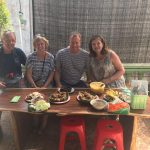Yogyakarta culture is varied and highly valued, especially traditional Javanese culture. Located in the heart of Java Island, Indonesia, is renowned for its rich cultural heritage, often referred to as “Jogja,” is a city steeped in rich traditions and arts. Yogyakarta has an Indonesian art institute school that has students from various regions in Indonesia and even abroad. Not only is it a school that is equivalent to a university, Yogyakarta has an art school that is equivalent to a high school.
Yogyakarta culture is a hub of traditional arts, including batik, wayang kulit (shadow puppetry), and gamelan music. Batik is a traditional Javanese fabric that is decorated with intricate patterns using wax and dye. Wayang kulit is a traditional form of shadow puppetry that tells stories from the Hindu epics, Ramayana and Mahabharata. Gamelan is a traditional Javanese musical ensemble that consists of various instruments, including metallophones, drums, and gongs. In the previous article I wrote about wayang kulit, gamelan and batik.

The city is a melting pot of architectural wonders. In addition to the Kraton. The Kraton Yogyakarta, also known as the Sultan’s Palace, is the center of Yogyakarta culture heritage. Kraton is also home to a variety of traditional arts performances, including gamelan music and wayang kulit. Yogyakarta boasts ancient temples like Prambanan, a UNESCO World Heritage Site. This magnificent Hindu temple complex showcases the grandeur of Javanese architecture and intricate stone carvings.
Traditional Ceremonies
Yogyakarta culture is not only in the arts, but there are still many other interesting thing such as Labuhan, sekaten, nyadran and genduri. The Labuhan ceremony is a ritual that is performed to appease the spirits of the sea. The Sekaten festival is a week long celebration that commemorates the birth of the Prophet Muhammad. Nyadran is an activity of cleaning graves and a ceremony to welcome the month of Ramadan. Genduri is a Javanese traditional ceremony to commemorate an event and also a banquet. After the kenduri event is finished, the community is also given food or certain items to take home.
Labuhan as a routine custom carried out by the courtiers and the people of Yogyakarta. Usually also followed by several domestic or foreign tourists, who happen to visit the southern coast of Yogyakarta or deliberately want to follow the Labuhan ceremony. Reported from the DIY cultural service page, the beginning of Labuhan began with Panembahan Senopati as the founder of the Islamic Mataram kingdom who made a cooperation agreement with the queen of the southern sea to get support. In return, Panembahan Senopati had to provide offerings in the form of Labuhan. Actually, many interpret Labuhan as another meaning, including those who interpret Labuhan as a prayer and hope to get rid of all kinds of bad traits. In Yogyakarta culture itself, Labuhan has 2 places, in Parangkusumo beach and Mount Merapi.
Sekaten festival is a week long celebration that commemorates the birth of the Prophet Muhammad. A traditional ceremony of the community that developed in the Yogyakarta area which is held periodically once a year. Sekaten as a means to spread Islam through the media of art, because in the past the Javanese people liked the art of gamelan or wayang kulit.
Culinary
Yogyakarta is also a culinary paradise, offering a wide variety of traditional Javanese dishes. Gudeg is a popular dish that is made from young jackfruit that is stewed in coconut milk and spices.
Bakpia is a typical Yogyakarta food brought from Chinese tradition. The central area of trade and manufacture is in the Patuk area of Yogyakarta city. Bakpia has various flavors including green beans, cheese, and chocolate. Along with the development of the times, bakpia has experienced various variations of fillings and flavors. Such as in the Bantul area there is bakpia filled with sweet potatoes with various flavors. Bakpia has an important role for the world of tourism in Yogyakarta, because it is a typical food that must be bought when visiting Yogyakarta.
Another Yogyakarta culture is a dish called Ayam Ingkung. Ayam Ingkung is a whole chicken cooked by braising and served with a separate curry sauce. This dish is usually served as a complement to offerings in wedding or death celebrations in Javanese customs.
Nasi Tumpeng or tumpeng rice is a food dish served in a cone shape and uses yellow rice, is decorated with various side dishes, vegetables and boiled eggs. Tumpeng rice is usually as a traditional ceremony in welcoming certain celebrations such as birthdays or thanksgiving.
Apem is a traditional Javanese cake made from rice flour, coconut, sugar and salt. Apem has a round shape and a chewy texture similar to serabi, can be cooked by baking or steaming. This food has an important meaning and symbol for Javanese people. Apem is often served at thanksgiving events, selamatan, and other celebrations.
Modern Influences
In addition to traditional culture, Yogyakarta is also a city that is open to modern influences. The city is home to a thriving arts scene, with many contemporary art galleries and studios. Yogyakarta is also a popular destination for students, with several universities located in the city. Yogyakarta culture is a living heritage that is constantly evolving. The city’s ability to blend ancient traditions with modern influences makes it a truly unique and captivating desrinations. If you visit Java and Yogyakarta in particular, you can contact kejawa.com to find out more about Yogyakarta culture. God Bless You !!!





 Mail Me
Mail Me

